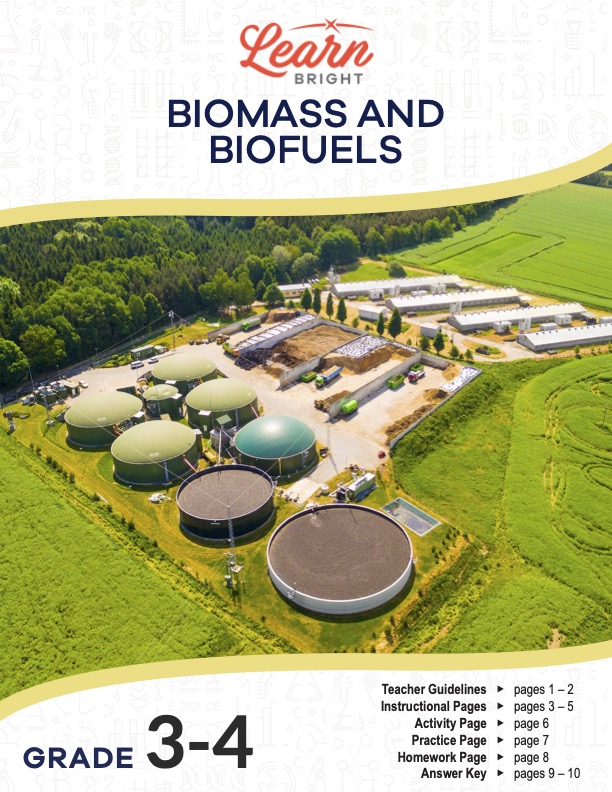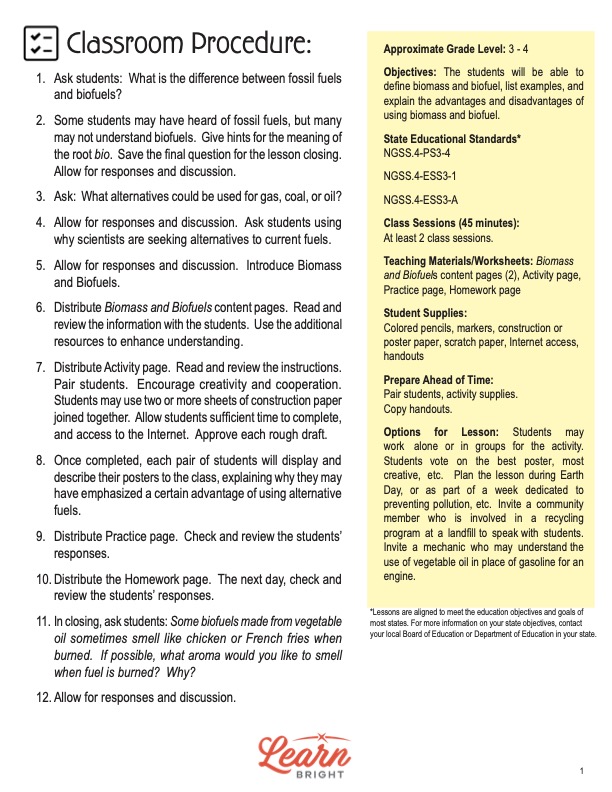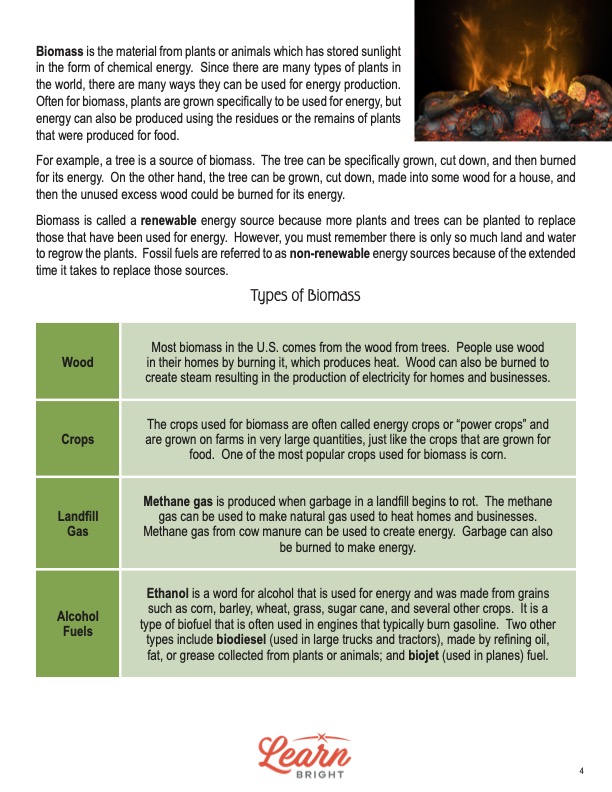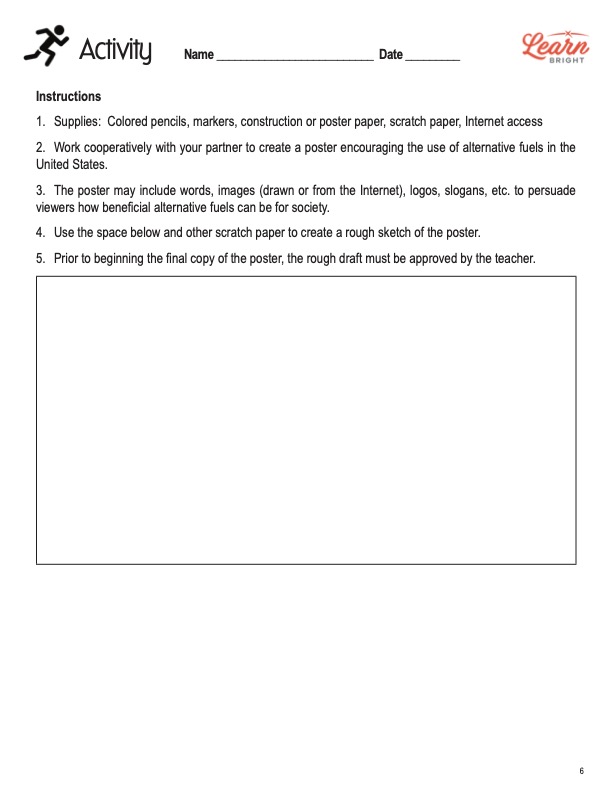Description
What our Biomass and Biofuels lesson plan includes
Lesson Objectives and Overview: Biomass and Biofuels teaches students about these concepts and what they mean. Students will discover examples of substances that fall into the categories. They will also learn some of the pros and cons of using these and will be able to explain these ideas to others. This lesson is for students in 3rd grade and 4th grade.
Classroom Procedure
Every lesson plan provides you with a classroom procedure page that outlines a step-by-step guide to follow. You do not have to follow the guide exactly. The guide helps you organize the lesson and details when to hand out worksheets. It also lists information in the yellow box that you might find useful. You will find the lesson objectives, state standards, and number of class sessions the lesson should take to complete in this area. In addition, it describes the supplies you will need as well as what and how you need to prepare beforehand. For this lesson, you will need to provide colored pencils or markers, construction paper or poster paper, and scratch paper. Students will also need access to the internet.
Options for Lesson
The “Options for Lesson” section provides several suggestions for additional activities or tasks that you could incorporate into the lesson if you have time or want to extend it. A couple of these ideas relate to the activity specifically. Students could work in small groups or alone rather than in pairs. After everyone finishes their posters, students could vote for posters in different categories, such as best, most creative, and most colorful. Another option is to plan the lesson during Earth Day or as part of a week dedicated to preventing pollution. You could also invite a community member involved in a recycling program at a landfill to speak with students and answer their questions. One more idea is to invite a mechanic who understands the use of vegetable oil in place of gasoline in an engine to speak with the class.
Teacher Notes
The paragraph on this page provides a little more information or guidance on what to expect from the lesson. It suggests that you teach this lesson in conjunction with others that relate to the environment, plants, pollution, and other similar topics. You can use the blank lines to record any thoughts you ideas you have as you prepare.
BIOMASS AND BIOFUELS LESSON PLAN CONTENT PAGES
What Does Bio- Mean?
The Biomass and Biofuels lesson plan contains a total of three pages of content. The lesson begins by explaining to students what the prefix bio- means. Many recognizable words have this prefix in them, such as biology, biodegradable, and biopsy. Each of these has something to do with life or living organisms. Knowing this, the lesson asks students what biomass and biofuel must mean.
The word mass is simply the material or substance that makes up everything in the world. Desks might consist of wood, tires are made from rubber, cars are metal, and so on. Biomass, then, is a material that comes from living things, particularly things made from plants and animals.
Fuel is another familiar word. These are materials like gas, coal, or oil that we burn in order to produce heat or power. Fuels are found in many places, such as school buses and other vehicles and buildings. There are two types of fuel. Fossil fuels are natural fuels formed in the earth from dead plants and animals. Biofuels, on the other hand, are ones that have been extracted from living plants. Biofuel, then, is a type of biomass.
Biomass
Every single living thing in the world obtains its energy from the sun. Plants absorb energy from the sun using photosynthesis. People get their energy by consuming plants or other animals that ate plants. So we still get energy from the sun, just not directly. Without the sun, people would have no energy. Granted, nothing would exist without the sun, let alone miss out on energy.
Biomass is the material from plants or animals that has stored sunlight in the form of chemical energy. Because there are so many types of plants in the world, there are lots of ways we can use them to produce energy. When it comes to biomass, people often grow plants specifically for energy production. However, we can also use the remains of plants that were produced for food.
For instance, a tree is a source of biomass. We could grow a tree specifically to cut it down and burn it for energy. On the other hand, we could use it as material to build a house and burn the unused excess wood for energy instead. The same concept of using excess substances applies to cooking oil. People can use excess vegetable oil from frying french fries to fuel their cars.
Biomass is a renewable energy source because we can plant more trees and plants to replace the ones we use for energy. However, there is only so much land and water that we can use to regrow the plants. Fossil fuels are non-renewable energy sources because of the extended amount of time it takes to replace them as a source of energy.
Types and Pros and Cons
Wood, crops, landfill gas, and alcohol fuels are all types of biomass. Most biomass in the U.S. comes from wood from trees. We use wood in our homes, both to build them and to keep them warm. In addition, we can burn wood to create steam and thereby produce electricity for our homes and businesses.
Crops used for biomass are often called energy crops or power crops. People grow these crops on farms in very large quantities, similar to crops for food. One of the most popular crops for biomass is corn. Landfill gas or methane gas is produced when garbage in a landfill begins to rot. We can use that gas to make natural gas. We can also burn garbage to make energy.
Finally, alcohol fuels include ethanol, biodiesel, and biojet. Ethanol is an alcohol that we use for energy, made from grains of corn, barley, wheat, sugar cane, and other crops. This is the type of biofuel people most often use in engines that typically burn gasoline. Biodiesel is for large trucks and tractors, and biojet is for planes.
There are, of course, both advantages and disadvantages to using biomass as an energy source. The cost to purchase is comparable while the benefit is higher. There are fewer emissions and fewer greenhouse gases, and biofuels produce less pollution. However, soil can lose vital nutrients, food shortages can occur causing spikes in food costs, and it uses large amounts of water.
BIOMASS AND BIOFUELS LESSON PLAN WORKSHEETS
The Biomass and Biofuels lesson plan includes three worksheets: an activity worksheet, a practice worksheet, and a homework assignment. Each worksheet helps reinforce students’ comprehension of the lesson material and allows them to demonstrate what they learned in different ways. Refer to the guidelines on the classroom procedure page to determine when to distribute the hand outs to the class.
ALTERNATIVE FUELS POSTER ACTIVITY WORKSHEET
Students will work with a partner to create a poster that encourages people to use alternative fuels. The posters can include words, images (either hand-drawn or from online), logos, slogans, and so on to show viewers how beneficial other fuel sources can be for society. Students can use the box on the worksheet to sketch a rough draft of the poster and then use construction paper or a poster board for the final copy. You will have to approve of students’ rough drafts before they begin work on their final drafts.
MATCHING AND YES OR NO PRACTICE WORKSHEET
The practice worksheet divides into two parts. For the first part, students will match definitions to the correct terms. There are 12 definitions and 12 terms in the word bank on the right-hand side of the page. The second part requires students to answer yes or no to eight questions. You may or may not choose to allow students to use the content pages for reference to complete this assignment.
BIOMASS AND BIOFUELS HOMEWORK ASSIGNMENT
Similar to the practice worksheet, the homework assignment has two sections. The first section requires students to decide whether each of 10 facts relate to wood (W), crops (C), landfill gas (L) or alcohol fuels (A). For the second section, students will respond to five prompts that require them to explain various concepts that relate to what they learned in the lesson.
Worksheet Answer Keys
The last pages of the PDF are answer keys for both the practice and homework worksheets. The correct answers are in red, which makes it easy to compare to students’ work. For the most part, students’ responses should mirror those on the answer keys. However, given the nature of the second part of the homework assignment, there will be some variation in students’ explanations. If you choose to administer the lesson pages to your students via PDF, you will need to save a new file that omits these pages. Otherwise, you can simply print out the applicable pages and keep these as reference for yourself when grading assignments.










